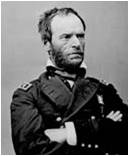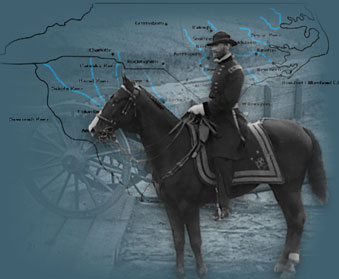CAROLINAS CAMPAIGN

Major General
William T. Sherman’s Carolinas Campaign spanned the final months
of the Civil War,
when the Confederacy faced an extremely bleak
military
situation.
In Virginia, Gen. Robert E. Lee’s Army of Northern Virginia
was
desperately
trying to prevent the capture of Richmond, the Confederate
capital,
and the vital
rail junction at Petersburg. In December 1864, Gen. John
B.
Hood’s Army of
Tennessee had met with disaster at Nashville at the hands
of
Union Maj. Gen.
George H. Thomas’ Army of the Cumberland, leaving
Hood’s
once-mighty army
a ghost of its former self. Sherman had only
recently
presented the
captured city of Savannah, Georgia, to President Abraham
Lincoln
as a “Christmas
gift.” Although the fall of Savannah was a tremendous blow
to
Southern morale,
it was Sherman’s drive to that coastal city from Atlanta
that
proved serious to
the Confederacy’s economic war effort. Sherman’s march
had
sliced through
the Confederate heartland and had disrupted the vital
logistical
resources that
Georgia had provided to the Southern cause. Sherman’s
successful
march to Savannah
defined how he expected to conduct future operations in
the
Carolinas.
Sherman hoped to accomplish two key strategic
goals in the Carolinas, both of
which would have serious consequences for Lee’s
Army of Northern Virginia. First, a march through the Carolinas would break
the back of the Confederate
logistics system, depriving the Confederacy of
its ability to sustain Lee’s army
in Virginia. Second, Sherman’s concept of
“hard war” would have an even more
devastating psychological effect on those
Carolinians serving in the Army of
Northern Virginia. Some units nearly
dissolved overnight as anxious men
deserted in hopes of reaching their families and
homes, which lay in the path of
Sherman’s army.In designing his expedition through the
Carolinas, Sherman drew upon the
invaluable experience gained during the March to
the Sea. He would cut loose
from his army’s logistical base at Savannah and
subsist his army off the land as
it moved. Sherman would employ a simple
concept for supplying his army: “where
other people live we can, even if they have to
starve or move away.”
In designing his expedition through the
Carolinas, Sherman drew upon the
invaluable experience gained during the March to
the Sea. He would cut loose
from his army’s logistical base at Savannah and
subsist his army off the land as
it moved. Sherman would employ a simple
concept for supplying his army: “where
other people live we can, even if they have to
starve or move away.”
As his army drove north, eviscerating the Carolinas, Sherman planned for his army to link up with other Union forces, which would advance from the coast of North Carolina. These forces would merge at Goldsboro, a key railroad junction in the Tar Heel State. These combined armies would then be linked to the-occupied coast by rail.
The above introduction is from my book “No Such Army Since the Days of Julius Caesar” Sherman’s Carolinas Campaign: Fayetteville to Averasboro co-authored with Mark A. Smith. I encourage those wishing to learn more about the campaign to visit several of the battlefield visitor centers located here in our state (see Links page) or take a moment to review my suggested reading list found on the bottom of this page. There is a wealth of information for one to explore. In an effort to broaden the publics knowledge of the campaign I have listed on this page additional links covering aspects not typically covered in detail by previous authors.
To learn more about the Carolinas
Campaign take a moment and review my
suggested, Further Reading
Link.
Maj. Gen. William T. Sherman
